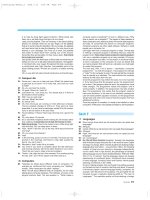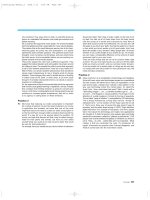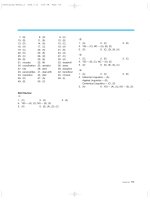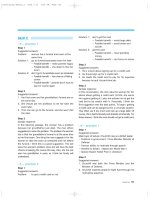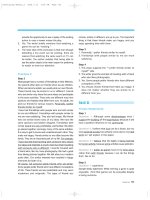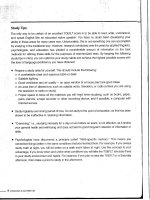Tài liệu Developing skills for the toefl ibt transcript part 2 ppt
Bạn đang xem bản rút gọn của tài liệu. Xem và tải ngay bản đầy đủ của tài liệu tại đây (77.08 KB, 10 trang )
Transcripts
665
areas, or “yards,” where steelpan music is played. Both meanings
of “panyard” were and still are important to communities in
the West Indies.
By the 1940s, steelpan music had spread from Trinidad to other
nearby West Indian islands. In 1951, steelpan was played for the
first time outside of the Islands when the Trinidad All Steel Percussion
Orchestra played at the Festival of Britain in the United Kingdom.
Now, as you all know... I hope... steelpan is popular across the
globe. In fact, let’s listen to some right now to end the class.
04 Campus Life
M: My dorm room looks like a cemetery. There are dead plants
everywhere!
W: My place used to look the same way but I’ve found the answer.
M: Really, what’s that?
W: Well, in some ways house plants are a little like pets.
M: Pets?
W: Yeah. They will probably be stressed when you first bring them
home.
M: Oh, so that’s why the leaves fall off during the first few days at
my place.
W: That’s right, but if you try to make the new home similar to the
old one, then they can still survive.
M: What do you mean?
W: Well, you need to make sure they have familiar conditions. You
may need to make some changes to your dorm room.
M: That sounds like a lot of work.
W: My thoughts exactly! I think it’s more prudent to choose plants
that match the conditions you already have in your room.
M: Of course. Why didn’t I think of that?
W: Just do some research and find plants that will be happy to live
at your place. Take a look over here...
M: Wow, those orchids look great!
W: Yes, they’re right at home in the bathroom with all that light
and moisture. That’s why I bought them.
M: What about that one over there?
W: Do you mean the aspidistra?
M: Er... yeah, I guess so.
W: It doesn’t need much sun, so I put it over in the corner.
M: So it’s as easy as that?
W: Well yes, just do your research first. You too can be an expert!
M: Thanks Anne. You won’t recognize my place the next time you
visit.
05 Education
M: Our lecture today will focus on success. In particular, I’d like to
explain how experts define success in children with learning
disabilities. Umm, did everyone read the article by Dr. Marshall
Raskind? Most of what I will talk about today comes out of that
article I gave you. It was the article, or interview really, in which Dr.
Raskind talked about how to define success for different kids.
In the interview, Dr. Raskind was asked two questions. First, he was
asked to define what success is. Secondly, he was asked to provide
a description of how kids with disabilities become successful adults.
These are two interesting, and not so easy, questions to answer.
Let’s start with Dr. Raskind’s definition of success. Dr. Raskind told
the interviewer that success means different things to different
people. However, he gave the interviewer a long list of factors
that seem to be common among successful people. These factors
include... umm, let me see... oh yes, having strong family ties,
having supportive friends, being loved, being physically and
mentally healthy, and having financial security. Also, successful
people generally have a feeling of meaning in their life. Dr. Raskind
pointed out that not all of these factors must be present to be
successful. Nonetheless, a very successful person might have
most of these factors: strong family ties, good friends, good
health, money, love, and meaning in his or her life.
So, these are the factors that determine success in normal people.
What about people with learning disabilities? Dr. Raskind, as well
as many other researchers, has done studies to determine the
success factors for people with learning disabilities. The factors
that have been identified with success for the learning disabled
are a little different. Those factors of success include, umm,
self-awareness, perseverance, support systems, and emotional
coping strategies. Remember, as with other people, not all of
these factors have to be present. Also, these success factors do
not guarantee that a learning disabled person will be successful.
However, they do increase their chances of success. Therefore,
friends and family of a person with a learning disability should try
to help the person be self-aware, choose his or her own actions,
and persevere, all the while encouraging him or her emotionally
as well.
It’s important to remember that success factors for the two
groups are slightly different. Not all factors have to be present
in a person’s life for them to be successful. Lastly, while these
factors increase a person’s chances for a successful life, success
is a subjective measure.
06 Biology
W: Many people think that dolphins and porpoises are exactly the
same. Although they are similar in many ways, a dolphin is not a
porpoise, and vice versa. There are both similarities and differences
between the two. Let’s learn about some of these similarities
and differences.
First, they are both mammals belonging to the scientific order
Cetacea. This order includes all whales, to which both dolphins and
porpoises are related. Second, both belong to the same scientific
suborder, Odontoceti. This suborder is made up of toothed whales.
However, they do not belong to the same scientific family. Porpoises
belong to the family Phocoenidae... that’s spelled P-h-o-c-o-e-
n-i-d-a-e... and dolphins belong to the family Delphinidae... that’s
D-e-l-p-h-i-n-i-d-a-e. OK, now, if we examine porpoises and
dolphins at this level, they are as physically different as dogs
and cats.
Let’s compare their physical characteristics. Porpoises are much
shorter than dolphins, but appear to be heavier. The porpoise’s
dorsal fin (that’s the fin on the back) is triangular. The dolphin’s
dorsal fin is shaped like a wave. The dolphin has a very noticeable
beak. The porpoise does not.
Because they belong to the same scientific order and suborder,
they share many of the same characteristics. For example, they
are both completely aquatic mammals (they live in the water),
they have a blowhole for breathing, and a tail fluke. However,
as mentioned before, they have many physical differences including
size and different shaped dorsal fins and beaks. Oh, and there was
one more difference I forgot to mention. The dolphin is thin and
sleek compared to the chubby porpoise. Remember, although
they appear very similar to us, at the family level, we can compare
their relationship, as we did earlier, to the one between cats and
dogs.
So, physically speaking, dolphins and porpoises are different. But
there are also behavioral differences between the two. Porpoises
are shy, while dolphins are not. Usually, porpoises only come up
out of the water to breathe. Dolphins are social. They will often
Developing-4Books_5 2006.7.13 3:48 PM Page 665
666
Transcripts
follow fishing boats. You are more likely to see a dolphin, both
in the wild and in captivity, than a porpoise.
Let’s review what we have discussed today. If you happened to
see a sleek mammal with a blowhole, a wave-like dorsal fin,
and a beak playing in the water near a boat, what would it be?
A dolphin. And if while scuba diving, you ran across a chubby
mammal with a blowhole and triangular dorsal fin that swam
away when you came near, what would it be? A porpoise.
Skill B
01 English
M: I think I’ve received everyone’s topic for your written project. At
least I hope I have, since the deadline was Friday. On that note,
we are going to spend today discussing writing tips. These tips
will help when you are planning and writing your essay. There
are four basic steps you can follow in writing for this class, or any
class really. When you are writing, you should look at planning,
composing, organizing, and finally, editing. Editing could include
fixing small things or revising the content of your essay. But we’ll
start with the first step, planning. Planning can include free
writing, brainstorming, outlining, and journaling.
W: Professor, what is free writing?
M: Good question. When we free write, we simply write down all
our thoughts on our essay topic. It helps us get a feel for our
subject. If we save our free writing to a computer file, we can
transfer the best parts of that file to our essay.
W: I understand. Thank you.
M: The next step is composing our essay. We should begin writing
by writing quickly. At this point, don’t worry about punctuation
or sentence structure. At this stage, you just want to get lots of
ideas down on paper. You can also use abbreviations if it helps
you write faster.
W: Excuse me. I have another question. Is it OK to use abbreviations
in our essays?
M: No, not in the completed essay. You should take out all the
abbreviations in your final essay. Also, once your rough composition
is complete, you must finalize the sentence structure and
punctuation. Think of it this way: once you’re finished composing,
a friend of yours should be able to pick up the paper and read
it. The essay is not organized yet, but it is r
eadable. Sentences
and punctuation should be in place, but no abbreviations. Next,
organize your essay. You can move sentences or even paragraphs.
This is easy if you use the cut and paste function on your computer.
Lastly, revise and proofread your essay before turning it in.
02 Linguistics
M: Good morning everyone. This morning I’d like to introduce you
to the concept of speech community, a concept belonging to
psycholinguistics. Um. It describes a particular group of people who
share certain characteristics and whose members all agree to use
language in a unique way. Confused? Let me see if I can make it
clearer for you. Speech communities can be groups of professionals
such as doctors, groups of students, perhaps high school students,
religious followers, or even groups of very close friends or family
members. Oh and let’s not forget online groups like regular
members of a chat room. Group members make up part of an
“in” group. Outsiders and non-members don’t understand the
speech and often feel excluded, whereas members feel a sense of
identity and belonging.
Think about groups you’ve encountered. I’m sure you’ll have
noticed that the stylistic features of speech communities differ
according to the group’s socioeconomic status, meaning their
social class or status in society. But a speech community might
also speak in a certain way because society expects them to.
We don’t expect doctors to speak in the same style as a group
of musicians, right? We expect more formal speech from our
medical practitioners, and we’d be shocked if our children spoke
to their friends in a formal style.
Each one of us here today is probably a member of several quite
different speech communities, and we almost certainly alter our
speech depending upon the community we are interacting with.
Think about it for a minute and I’m sure you’ll recognize what
I’m talking about. I’ll use myself as an example. I certainly use
a very different style of speech with my group of golf buddies,
guys I’ve known since grade school, than I do with my group of
academic colleagues. Take a moment to think about your own lives.
A r
eal challenge can occur --- I’m sure you’ll know what I mean
here too --- when you find yourself interacting with speakers
from two or more of these speech communities of which you
are a member. You have to find a way to make your speech appeal
to speakers from both or all communities. Imagine you’re trying
to interact with a group of close family members AND members
of your peer group over dinner. I see you know what I mean. It may
not be as relaxing as talking with just one speech community at a
time.
03History
M: The focus of our lecture this morning will be on the OECD. We
will learn about what it is, talk briefly about its history, and consider
what it does today. We have a lot to cover, so listen carefully.
Some of you know what I mean by the OECD, others may not.
OECD stands for the Organization for Economic Cooperation
and Development. Quite a long title! The abbreviation OECD is
much easier to remember and say. The Organization for Economic
Cooperation and Development is a mouthful. Now, you are probably
wondering exactly what the OECD is. Well, it is an international
organization. Its members are developed countries that believe in
democracy and a free market economy.
Let’s start with a bit about its history. The OECD came into being
to help rebuild Europe after the Second World War. I’m sure you’re
all familiar with the destruction in Europe, especially in France,
England, and Germany, at that time. Originally, only European
countries were members. In 1961, however, non-European members
were admitted, and its scope became more international.
Today, the OECD is a group of like-minded countries. They help
the governments of countries become prosperous and fight
poverty. To be more specific, the OECD helps provide economic
growth, financial stability, technology, and trade and investment.
Oh, and, umm, the organization is also aware of the importance
of the environment. They work hard to ensure that achieving
prosperity does not mean ruining the environment.
The OECD also helps governments understand and respond to
new developments in the areas of terrorism, new technologies,
and ageing populations. In other words, the OECD changes with
the times.
The OECD also collects statistical, economic, and social data.
This data is highly respected and used by researchers worldwide.
So, to recap, this is what we have discussed so far. This will be on
the test, so you may want to write it all down. The OECD was
formed to help the rebuilding of Europe. In 1961, its membership
Developing-4Books_5 2006.7.13 3:48 PM Page 666
Transcripts
667
expanded from European-only countries to democratic and free
market economy countries around the world. Today, the OECD
helps countries become prosperous and fight poverty. The
organization also helps governments understand terrorism, new
technologies, and ageing populations. It is also a well-respected
collector of statistical, economic, and social data.
I want you to understand that while the OECD has only 30
members, non-members can subscribe to OECD agreements and
treaties. The organization shares its information and expertise
with more than 100 countries.
04 Campus Life
M: Hi Sarah, what’s up?
W: I’m checking out the college course catalog for next semester.
M: Oh really? Which college are you looking at?
W: I’m looking at Woods College. They have lots of good courses
in the catalog here.
M: Woods College? I know that is a very good school, but it is so
far away!
W: I know! That’s true. Woods College is halfway across the country
from here.
M: Well, how can you go there? I mean, you have a job here. And
you have to work to help support your family. Are you really
contemplating leaving this city to go study at Woods?
W: Oh no! I couldn’t leave this city. After all, I have a job and a
family.
M: Then how can you study there? Why even bother looking at the
catalog?
W: Because I can take classes through their “Distance Learning”
program.
M: What’s a “Distance Learning” program? I’ve never even heard
of one of those!
W: Well, it’s kind of new. “Distance Learning” means that you can
take classes at a college that is in a different city or state, but
you can take the classes from your home.
M: How can you take classes from a college if you don’t even live
there?
W: Through your computer. It’s like taking classes over the Internet.
M: Wow --- over the Internet! That sounds convenient. And probably
fun, too!
W: Yes. It requires some technology. For example, you have to have
your own computer.
M: What do you need besides a computer? Do you need some
kind of special connection to the Internet at home?
W: You need a computer with a modem, and an Internet connection.
That’s it. Nothing special.
M: Is there anything else you need?
W: You need a lot of memory on your computer. Some schools
recommend having several gigabytes of free space. You need
lots of memory to store the files and lectures on your computer.
M: I have a computer with an Internet connection, but not much
memory.
W: You could always buy some extra memory for your computer.
Upgrade it. It’s really not too expensive. Then you could take
distance learning classes with me! It’d be fun!
M: Y
ou’re right. And taking extra college classes would look good
on my resumé.
W: You bet. Why don’t you sit down and look at the catalog with me?
05 Health
W: Today, I want to consider natural alternatives to aspirin for pain
relief. You may know that before aspirin, people used salicin to
fight pain. Salicin is quite different from aspirin and occurs naturally
in plants such as willow bark and meadowsweet, among others.
Many doctors believe it may be safer to use these natural sources
of salicin rather than aspirin. Let me explain exactly why it might
be a good idea to throw away our bottles of aspirin and reach
for the herbal preparations.
Why do we use aspirin? It helps get rid of our headaches, right?
Yes, it does. So, what are the problems with using aspirin? Well,
aspirin can also produce some harmful side effects. We want the
pain relief from aspirin, but we don't want the stomach irritation,
the thinning of the blood, and the allergic reactions. What about
the side effects of the natural sources of salicin, you might ask.
Well, it’s interesting to note, and this is important, there is no
evidence to suggest that these natural sources produce similar
negative side effects --- in fact, they can often be used to treat
these negative side effects!
OK, so aspirin can cause stomach problems, thin blood, and
allergic reactions. Let’s look more closely at some of the natural
sources of salicin. We’ll start with willow bark. Willow bark can
relieve stomach irritation and actually stop minor bleeding, one of
the side effects of aspirin! Willow bark has been used for centuries.
It became popular in treating the inflammation associated with,
ahh, gout ...a very painful disease. In addition, it can reduce fevers
and kill intestinal worms. Then, there’s meadowsweet. It can aid
digestion, calm irritated stomachs, and, like willow bark, it can
stop minor bleeding. Again we have an herbal preparation that
can treat conditions that aspirin may actually cause!
So, to recap. There are proven negative side effects associated
with the use of aspirin and no evidence to suggest similar negative
side effects with the use of herbal preparations. Sources of salicin
such as willow bark and meadowsweet are readily available today,
and for many people, may provide a safe alternative to aspirin.
06Cultural Studies
W: This lecture is going to introduce you to traditional Chinese philosophy.
First, you will learn about, uh, the yin and yang philosophy.
Secondly, we will look at the five elements of this philosophy. It
is important that you remember these five elements as we will
be discussing them throughout the lecture. The five elements of
yin and yang are: water, wood, fire, earth, and, umm, metal.
OK, so those are the five elements. Umm, let’s begin with a
definition of yin and yang. Yin and yang should be considered
as opposite forces like, uhh, like land and ocean, for example
.
These are opposites. Now, these opposites do not compete with
each other. They are complementary. When you think of yin and
yang, think complementary opposites.
So, moving from complementary opposites, let’s return to the
five elements we mentioned earlier. If you recall, we said they
were water, wood, fire, earth, and metal. The Chinese divided yin
and yang into five elements to gain an understanding of how the
body, mind, and spirit work. According to the Chinese, every
person’s physical and mental health relies on a balance of the
five elements. Individuals may have more of one element than
another. Of course, ideally, all elements are in balance or harmony.
What does this mean? Uh, it means that a person’s body contains
equal amounts of each element.
The amount of each element in an individual’s body determines
his or her physical and mental health. When all of the elements
are equal, a person is healthy. When they are not equal, or there
is an imbalance, you get sick. The type of sickness depends on
the elements that are out of balance.
OK, we’re going to get into these specific illnesses next time.
Developing-4Books_5 2006.7.13 3:48 PM Page 667
668
Transcripts
Before you go, let’s review what we have covered today. We
have defined yin and yang. They are complementary opposites.
Secondly, we discussed the five elements of yin and yang. They
are water, wood, fire, earth, and metal. These elements are always
changing, and the balance of these elements within our bodies
determines our health.
Skill C
01 Campus Life
W: Hi! I need some information about the Student Activity Fee.
Can you help me?
M: Sure. What would you like to know?
W: Well, first of all, what exactly is the Student Activity Fee?
M: Well, that’s easy. The fee is $15.00, and since autumn 2003 all
students entering the university have been required to pay it.
W: All students must pay it?
M: That’s right. It’s a quarterly fee paid by undergraduate and graduate
students.
W: Paid quarterly! Wow, I thought it would just be once a year.
M: Nope
.
W: How much money does the university collect from this fee?
M: Right now, there is a little over $2 million in the fund.
W: That’s a lot of money. Who decides how it is spent?
M: That would be the council on Student Affairs. You will find both
students and faculty making the spending decisions.
W: I see. Do I have my facts correct? The fee is $15.00 per quarter,
per student. Both students and faculty decide how the money
will be spent.
M: Exactly!
W: Now, I know who decides on how the money is spent. Can you
tell me what types of programs receive funds?
M: The list is a long one. It includes free concerts, lectures, comedy
shows, second run films, late night programming. Just about any
worthwhile student program or event can obtain funding.
W: Can I become involved?
M: Of course. The easiest way to get involved is to join the student
union. They are always looking for students with good ideas.
W: I will think about that. It would be fun to find ways to spend
the student activity fee. Thanks for all your help.
M: You’re welcome.
02 History
W: First up this morning, I’m going to talk about Her Majesty the
Queen of England’s official Palace and Fortress, the Tower of
London. After briefly touching on its, umm, construction and
location, I want to focus on a couple of its historical uses. Over
time, the Tower has been used for pleasurable purposes and for
truly terrible purposes. I will discuss one example of each: the
Tower as a zoo and the Tower as a place of imprisonment and
execution. OK, let’s begin.
The Tower of London is actually a complex of buildings. It’s situated
along the River Thames in London. Its name comes from one
particular building, the, uhh, the White Tower built by William
the Conqueror in 1078. It is surrounded by a moat, a channel
of water that goes all the way around it.
The use of the tower changed from being a fortress at, uh, at
around the beginning of the thirteenth century. At that time,
a Royal Menagerie, which is a fancy word for “zoo”, was established
at the Tower. Much later, this was opened to the public so that
commoners could also enjoy the animals. Unfortunately, the
animals at the Royal Menagerie were not particularly well cared
for. Eventually, they were all moved to the New London Zoo,
which opened in Regent’s Park in, uh, in 1835.
Now, for the dark side of The Tower, and by dark, I mean truly grim.
For a very long time, the Tower of London was used as a prison
and a place of public and private execution. Beheading was a
popular method. This involved chopping the head off a prisoner
with an axe, not always a very sharp one. The executioner often
had to swing the axe several times. Hanging was another popular
method, usually reserved for the lower classes. Sometimes, public
executions provided great, uh, great entertainment, believe it
or not. This was especially the case when condemned prisoners
were famous people. Examples of famous people who were
publicly executed are Sir Thomas More and Queen Anne Boleyn.
In fact, some people say Queen Anne still walks around the
Tower carrying her head under her arm!
So, just to recap before we break. The tower of London was
originally built as a defensive fortress by William the Conqueror in
1078. Starting in the 1200s, it was used as a zoo for royalty, and
later, for commoners, too. Finally, it was used as a prison and a
place for public execution.
03 Music
M: Today, we will continue talking about great opera composers.
I’m sure you remember from yesterday’s lecture that there are
many fantastic opera writers. Now I’d like to give you some
information about another very famous composer. His name is
Giuseppe Verdi.
Like most composers, Giuseppe Verdi is normally called by his last
name only. Verdi was born in 1813. With a name like Giuseppe
Verdi, where do you think he might be from? Of course, Verdi
is from Italy. Verdi began to show a great interest in music at an
early age. At only eight years old, Verdi began to play musical
instruments. Do you have any idea what his first instrument
was called? Now, this is just a “fun fact” --- you don’t need to
memorize this! His first instrument was called a “spinet.”
Like I was saying, Verdi’s family quickly realized his great interest
in music and sent him to study music formally. By the time Verdi
was ten years old, he was studying at a music school and taking
private music lessons. He studied with some very good musicians.
So you can see that Verdi not only had natural talent, but he also
practiced to become a great musician.
When Verdi was 26 years old, he wrote an opera called Oberto
Conte di San Bonifacio. Don’t worry about writing down the
whole name of that opera. We can just refer to it as Oberto for
short. You can copy down the full names of Verdi’s operas from
my website. What’s really important here is that this opera,
Oberto,really was the beginning for Verdi’s success. Although
Oberto was not a huge success itself, it was successful enough to
earn some recognition for Verdi. After writing Oberto, Verdi
went on to write many more operas. And with each opera, Verdi
became more and more famous.
What is interesting about Verdi’s fame is that people who
supposedly knew a lot about music at that time didn’t like him.
In his time, Verdi had a lot of critics. There were many people
who did not like his work. However, most of these people were
music critics, that is, people who evaluated music and were
considered professionals. The critics particularly disliked some of
Verdi’s operas because of their political messages. Verdi’s real
fans, though, were the common people. He was liked more by
the public than the musical elite, the critics of his day.
Developing-4Books_5 2006.7.13 3:48 PM Page 668
Transcripts
669
04 Geography
M: Did everyone see the title of today’s lecture? “The Great Lakes
of North America.” You are all nodding yes. That’s great! Now,
who can tell the class how many lakes there are, and their names?
W
1
: I think there are four lakes. Names? Ummm, let’s see: Ontario,
Michigan, Erie and Superior.
M: Good guess. You have the four names right, but there are five
lakes, not four. Can anyone recall the name of the fifth Great
Lake?
W
2
: Isn’t it Heron or Huron?
M: It’s Huron. The five Great Lakes are: Huron, Ontario, Michigan,
Erie, and Superior. There is an easy way to remember them. Anyone
know how to easily memorize the names of these lakes? No?
The easiest way to remember them is to use an acronym. An
acronym is an abbreviation in which each of the letters stands
for the letter in a list of words to be remembered. The acronym
for the five Great Lakes is HOMES. If you remember this acronym
you can effortlessly recollect the name of each Great Lake: Huron
--- H, Ontario --- O, Michigan --- M, Erie --- E, Superior --- S.
W
1
: That’s cool. It makes remembering the names really easy.
M: Let me share a bit more information with you about the Great
Lakes. Lake Superior is the largest and the deepest. Therefore,
the name Superior. Lake Ontario is the smallest in area. The
only Great Lake entirely in the US is Lake Michigan. All of the
other lakes are partially in the US and partially in Canada. Now,
let’s review. What is the acronym?
W
1
: HOMES : Huron, Ontario, Michigan, Erie, Superior.
M: Largest?
W
2
: Lake Superior.
M: Great! You should have no trouble with the Great Lakes on the
exam.
05 American Studies
W: We all know that wars are difficult. They’re difficult for soldiers
sent away to battle, of course, but they’re also difficult for people
back home. Today, I’d like to talk about some of the hardships
people faced in the, uh, US during World War I and II. Now, one
major hardship was the lack of food. All of those troops fighting
overseas needed to eat. Ask yourselves, “Where does that food
come from?” It comes from the same farms that produce food in
peace time, except that a lot of the farmers are now gone to war.
During wars, you see, the public food supply often runs short.
So, to, uh, help solve this problem, the US government encouraged
private citizens to grow their own food. They asked people to
plant their own gardens and feed their own families. These gardens
were called victory gardens. In these victory gardens, people
tried to grow their own vegetables, fruits, and even herbs to
use in cooking.
So, how successful do you think these victory garden campaigns
were? Can you imagine turning your backyard into a vegetable
garden? No? Not many of you, huh? No green thumbs in this
class? Actually, victory gardens worked really well in the US. The
government placed posters about victory gardens everywhere.
As an example, in 1944, the posters had the words “Plant more
in ‘44” on them. This resulted in over, uh, over 20 million Americans
planting victory gardens. Pretty impressive, huh? These gardens
produced a huge amount of food. In fact, historians estimate
that forty percent of all of the vegetables consumed in the US
that year were from victory gardens. This meant that, umm, more
vegetables from large farms could be canned or processed and
then shipped overseas to feed the troops.
Victory gardens were a huge success during both World War I
and II. As a result of private citizens’ efforts, both the troops
and the public were able to have enough food during the war
years. When World War II ended in 1945, people were ready to
get back to normal life, but, uhh, unfortunately, there were still
hardships to face. Believe it or not, one of these hardships was a
lack of food. You see, once the war was over, people immediately
stopped planting their victory gardens. They expected that food
production would go back to normal immediately. Of course, this
was not the case. It took some time for production to get back to
normal. As a result, the public actually experienced worse food
shortages in peace time than during either World War I or II!
06 English
W: What would you say if I told you all humans are cats?
M: I might say you’re crazy.
W: Ha ha. OK. Fair enough. That statement does seem kind of crazy.
Why does it seem crazy? Because we know it’s wrong. We all
know it’s wrong. Today, we’re going to look at fallacies. Fallacies
are errors in reasoning, umm, wrong thinking, if you will. An
argument that contains a fallacy is said to be invalid or unsound ---
or “crazy” as some of you might put it. Now, we can test the
validity of an argument by checking to see if it contains any fallacies.
The ability to test for fallacies is essential to critical thinking, and
critical thinking is essential to earning a high grade in this class,
so pay close attention.
Now, we will look at one category of fallacy --- umm, formal
fallacies. Formal fallacies are only found in one, uh, particular
kind of argument --- the deductive argument. The simplest kind
of deductive argument has two statements or assumptions and
then a conclusion. It’s called a syllogism. That’s S-Y-L-L-O-G-I-S-M.
Now don’t get confused by big terms like this; remember, a
syllogism is an argument with two assumptions and a conclusion...
it’s simple stuff, really. OK, now, if the two statements or assumptions
are true AND provide complete support for the conclusion, then
we say the argument is valid, and there is no error in reasoning, no
formal fallacy. However, even when the two statements are true,
if they don’t provide enough, umm, support for the conclusion,
then we say the argument contains a formal fallacy and is invalid.
More simply put, the argument contains errors in the reasoning,
or if you prefer, it’s “crazy.” Here’s an example of a syllogism
containing a formal fallacy:
1. All humans are mammals... that’s a true statement.
2. All cats are mammals... that’s a true statement, too.
3. Therefore, all humans are cats... that’s an incorrect, or crazy,
conclusion. We already know this.
You see, each statement is true... all humans ARE mammals,
and all cats ARE mammals. But these two statements do not
completely support the conclusion. The conclusion: “Therefore, all
humans are cats,” is clearly false. The fact that humans and cats
both belong to the same family of animals that we call mammals
DOES NOT mean that humans and cats are the same thing. There
is a formal fallacy in the argument. Remember, formal fallacies
are mistakes in the logic of a, uh, deductive argument, and a
deductive argument with two statements and a conclusion is
called a syllogism. It’s very important to remember, then, when
you are making arguments for my class... or for any of your
other classes... to check for and avoid formal fallacies.
Developing-4Books_5 2006.7.13 3:48 PM Page 669


